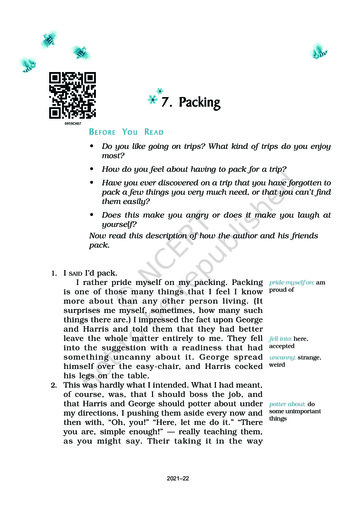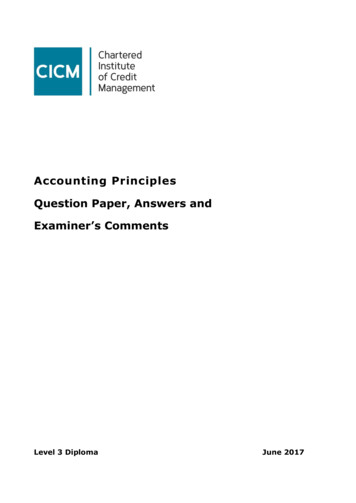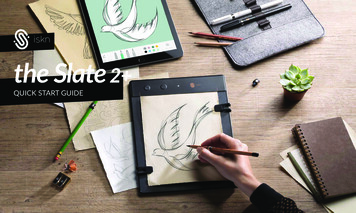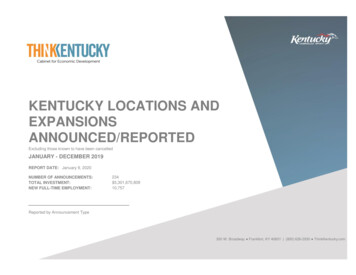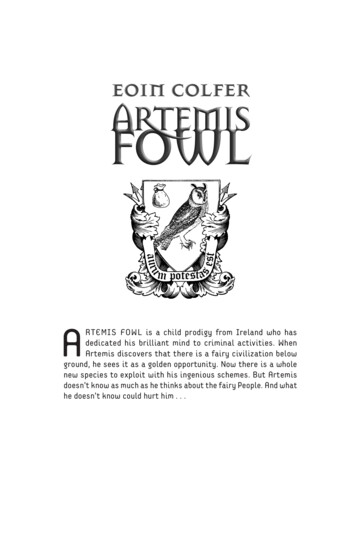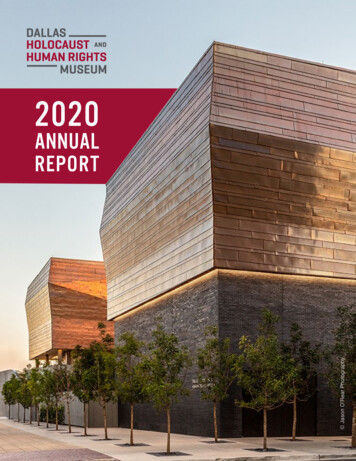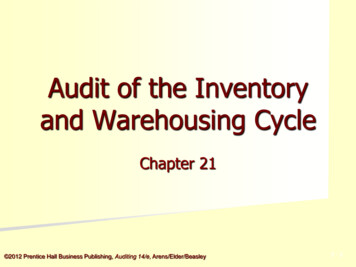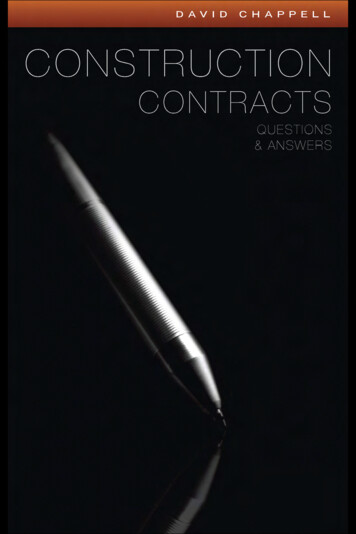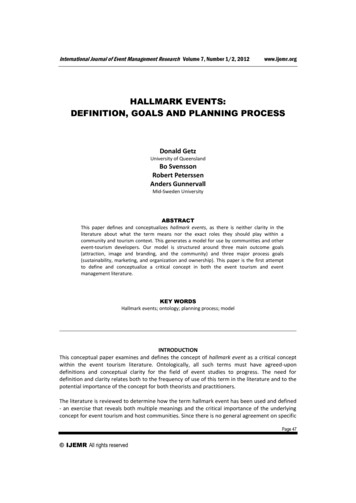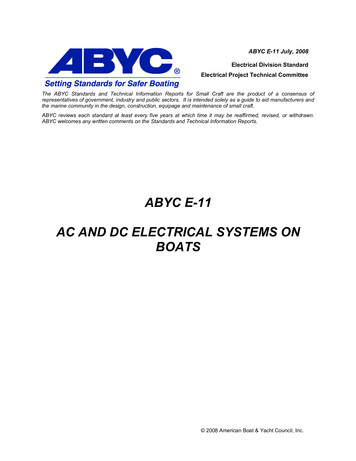
Transcription
ABYC E-11 July, 2008Electrical Division StandardElectrical Project Technical CommitteeThe ABYC Standards and Technical Information Reports for Small Craft are the product of a consensus ofrepresentatives of government, industry and public sectors. It is intended solely as a guide to aid manufacturers andthe marine community in the design, construction, equipage and maintenance of small craft.ABYC reviews each standard at least every five years at which time it may be reaffirmed, revised, or withdrawn.ABYC welcomes any written comments on the Standards and Technical Information Reports.ABYC E-11AC AND DC ELECTRICAL SYSTEMS ONBOATS 2008 American Boat & Yacht Council, Inc.
E-117/08ELECTRICAL PROJECT TECHNICAL COMMITTEEWilliam Drake, ChairmanRichard BlackmanNigel CalderRobert CarlsonPete ChisholmJames ClausenBen CraigWm. Brian CraigDennis DodgeJim EichnerWard EshlemanPaul FleuryCharles GameRobert GreenMark GropperClyde HeadRoger JarmanRalph LambrechtRobert LoeserKeith LovegrenKim MacCartneyThomas MarhevkoVinod MehtaAaron MeyerPaul MichalczykJohn PageDave PotterDonald ReedBruce SlaughterRobert UngerThis list represents the membership at the time the Committee was balloted.NOTE: Membership on a committee shall not in and of itself constitute an endorsement of ABYCor any document developed by the committee on which the member serves.This Standard was developed under procedures accredited as meeting the criteria for American NationalStandards. The Project Technical Committee that approved the Standard was balanced to ensure thatindividuals from competent and concerned interests have had an opportunity to participate.This Standard, which is the result of extended and careful consideration of available knowledge andexperience on the subject, is intended to provide minimum performance requirements.ABYC’s Project Technical Committee meetings are open to the public. All inquiries regarding standardsactivity, interpretations, or meeting attendance should be directed to the ABYC Technical Department atcomments@abycinc.org.ABYC and its committees do not “approve”, “certify”, or “endorse” any item, construction, or proprietarydevice.REQUEST FOR INTERPRETATIONSUpon written request the Electrical PTC will render an interpretation of any requirement of the Standard.The request for interpretation should be clear and unambiguous. Requests should be presented to the PTCin a manner in which they may be answered in a yes or no fashion.The committee reserves the right to reconsider any interpretation when or if additional information whichmight affect it becomes available to the PTC. Persons aggrieved by an interpretation may appeal to theCommittee for reinterpretation. 2008 American Boat & Yacht Council, Inc.
E-117/08E-11 AC and DC Electrical Systems on BoatsTable of Contents11.1PURPOSE . 111.2SCOPE . 111.3REFERENCED ORGANIZATIONS. 111.4DEFINITIONS . 211.5GENERAL REQUIREMENTS . 511.6POWER SOURCE . 911.7ISOLATION OF GALVANIC CURRENTS .1311.8LOAD CALCULATIONS.1411.9PANELBOARD.1711.10OVERCURRENT PROTECTION .1811.11GROUND FAULT PROTECTION – AC SYSTEMS .2211.12SWITCHES .2311.13PLUGS AND RECEPTACLES .2311.14.SYSTEM WIRING .2411.15APPLIANCES AND EQUIPMENT.3011.16DC GROUNDING AND BONDING .3111.17APPLICATION OF TYPES OF SHORE POWER CIRCUITS.32INDEX .73NOTE: GREY SHADING INDICATES AN AC ONLY REQUIREMENT.LACK OF SHADING INDICATES GENERAL OR DC ONLY REQUIREMENTS. 2008 American Boat & Yacht Council, Inc.
E-117/08E-11 AC and DC ELECTRICAL SYSTEMS ON BOATSBased on ABYC's assessment of the existing technology, and the problems associated with achieving thegoals of this standard, ABYC recommends compliance with this standard for all systems and associatedequipment manufactured and/or installed after July 31, 2009.11.1PURPOSEThese standards are guides for the design, construction, and installation of alternating current (AC) electricalsystems on boats and of direct current (DC) electrical systems on boats.NOTE: The United States Coast Guard has promulgated mandatory requirements for electricalsystems in Title 33, CFR 183 Subpart I, Section 183. Refer to the CFR for current federalrequirements.11.2SCOPEThese standards apply:11.2.1to alternating current (AC) electrical systems on boats operating at frequencies of 50 or 60hertz and less than 300 volts, including shore powered systems up to the point of connection to the shoreoutlet and including the shore power cable and,11.2.2to direct current (DC) electrical systems on boats that operate at potentials of 50 volts or less.EXCEPTION: Any conductor that is part of an outboard engine assembly and does not extendbeyond the outboard engine manufacturer’s supplied cowling.11.3REFERENCED ORGANIZATIONSABYC - American Boat & Yacht Council, Inc., 613 Third Street, Suite 10, Annapolis, MD 21403. Phone:(410)990-4460, Fax: (410)990-4466. Website: www.abycinc.orgABYC A-1, Marine Liquefied Petroleum Gas (LPG) SystemsABYC A-3, Galley StovesABYC A-16, Electric Navigation LightsABYC A-22, Marine Compressed Natural Gas (CNG) SystemsABYC A-28, Galvanic IsolatorsABYC A-31, Battery Chargers and InvertersABYC E-2, Cathodic ProtectionABYC E-10, Storage BatteriesABYC H-2, Ventilation of Boats Using GasolineABYC H-24, Gasoline Fuel SystemsABYC H-33, Diesel Fuel SystemsABYC T-5, Safety Signs and LabelsABYC TE-4, Lightning ProtectionABYC TH-22, Educational Information About Carbon MonoxideABYC TH-23, Design, Construction, and Testing of Boats in Consideration of CarbonMonoxide.1 2008 American Boat & Yacht Council, Inc.
E-117/08CFR - Code Of Federal Regulations and other government publications. Obtain from the Superintendent OfDocuments, United States Government Information, POB 371 954, Pittsburgh, PA 15250-7954. Phone:(202)512-1800 or Fax: (202)512-2250. Website: www.access.gpo.gov An excerpted edition of the CFR isalso available from ABYC, Inc.33 CFR 183.410(a)IEC – International Electrotechnical Commission, 3, rue de Varembe, PO Box 131, CH – 1211 GENEVA 20,Switzerland. Phone: 41 22 919 0211. Fax: 41 22 919 0300. Website: www.iec.chIEC Standard 60529 Type IP67IEC Standard 60529 Type IP 54.thNEMA - National Electrical Manufacturer's Association, 1300 North 17 St, Suite 1847, Rosslyn, VA 22209.Phone: (703)841-3200, Fax: (703)841-5900. Website: www.nema.orgStandard 250, Type 6PStandard 250, Type 3NFPA - National Fire Protection Association, One Batterymarch Park, Quincy, MA 02269-9101. Phone:(617)770-3000. Fax: (617)770-0700. Website: www.nfpa.orgNFPA 70, The National Electrical CodeSAE - Society of Automotive Engineers, 400 Commonwealth Drive, Warrendale, PA(724)776-4841. Fax: (724)776-5760. Website: www.sae.org15096.Phone:SAE J1171, External Ignition Protection of Marine Electrical DevicesSAE J378, Marine Engine WiringSAE J1127, Battery CableSAE J1128, Low-Tension Primary CableUSCG - United States Coast Guard, USCG Headquarters, Washington, DC, 25093-0001. Coast GuardWebsite: www.uscgboating.org.UL - Underwriters Laboratories Marine Department, POB 13995, 12 Laboratory Drive, Research TrianglePark, NC 27709. Phone: (919)549-1400. Fax: (919)547-6000. Website: www.ul.comUL 83, Thermoplastic-Insulated Wires and CablesUL 94, Tests For Flammability Of Plastic MaterialsUL 310, Electrical Quick-Connect TerminalsUL 489, Molded Case Circuit Protectors For Circuit Breaker EnclosuresUL 498, Attachment Plugs and RecepticlesUL 514A, Metallic Outlet BoxesUL 514B, Nonmetallic Outlet Boxes, Flush Device Boxes, and CoversUL 943, Ground Fault Circuit InterruptersUL 1053, Ground Fault Sensing and Relaying EquipmentUL 1059, Terminal BlocksUL 1077, Supplementary Protectors For Use In Electrical EquipmentUL 1426, Cables for BoatsUL 1500, Ignition Protection Test For Marine ProductsUL 1561, Dry Type General Purpose and Power Transformers11.4DEFINITIONSFor the purposes of this standard, the following definitions apply.11.4.1 AC grounded conductor - A current carrying conductor that is intentionally maintained at groundpotential.NOTE: This may be referred to as the neutral (white) conductor in AC electrical systems.2 2008 American Boat & Yacht Council, Inc.
E-117/0811.4.2 AC grounding conductor (green or green with a yellow stripe) - A conductor, not normally carryingcurrent, used to connect the metallic non-current carrying parts of AC electrical equipment to the ACgrounding bus, engine negative terminal or its bus, and to the source ground.NOTE: The source of electrical power may be the shore AC power, an inverter, an isolationtransformer or a generator.o11.4.3 Battery cold cranking performance rating 0 F (-17.8 C) - The discharge load in amperes that abattery at 0 F (-17.8 C) can deliver for 30 seconds, and maintain a voltage of 1.2 volts per cell or higher,e.g., 7.2 volts for a 12 volt battery.11.4.4 Battery reserve capacity - The number of minutes a new fully charged battery at 80 F (26.7 C) canbe continuously discharged at 25 amperes, and maintain a voltage of 1.75 volts or higher per cell, e.g., 10.5volts for a 12 volt battery.11.4.5 DC grounded conductor - A current carrying conductor connected to the side of the power sourcethat is intentionally maintained at boat ground potential.11.4.6 DC grounding conductor - A normally non-current carrying conductor used to connect metallic noncurrent carrying parts of direct current devices to the engine negative terminal, or its bus.11.4.7 Double insulation system - A system comprised of basic insulation and supplementary insulation,with the two insulations physically separated and so arranged that they are not simultaneously subjected tothe same deteriorating influences, e.g., temperature, contaminants, to the same degree.11.4.8 Engine negative terminal - The point on the engine at which the negative battery cable isconnected.11.4.9 Equipment enclosure - The outside shell of equipment that provides personnel protection fromelectrical hazards, burns, rotating machinery, sharp edges, and provides protection to the device frommechanical damage or weather.11.4.10 Equipment Leakage Circuit Interrupter (ELCI) - A residual current device which detects equipmentground fault leakage current and disconnects all ungrounded (110 V & 240V) and grounded (110 V neutral)current carrying conductors from the supply source at a preset trip threshold.11.4.11 Galvanic isolator - A device installed in series with the (AC) grounding (green) conductor of theshore power cable to effectively block low voltage (DC) galvanic current, but permit the passage ofalternating current (AC) normally associated with the (AC) grounding (green) conductor.11.4.12 Ground - The potential of the earth's surface. The boat's ground is established by a conductingconnection (intentional or accidental) with the earth, including any conductive part of the wetted surface of ahull.11.4.13 Ground fault circuit interrupter (GFCI) - A device intended for the protection of personnel thatfunctions to de-energize a circuit, or portion thereof, within an established period of time when a current toground exceeds some predetermined value that is less than that required to operate the overcurrentprotective device of the supply circuit.11.4.14 Ground fault protector (GFP) - A device intended to protect equipment by interrupting the electriccurrent to the load when a fault current to ground exceeds some predetermined value that is less than thatrequired to operate the overcurrent protection device of that supply circuit.11.4.15 Ignition protection - The design and construction of a device such that under design operatingconditions:a. it will not ignite a flammable hydrocarbon mixture surrounding the device when an ignition source causesan internal explosion, orb. it is incapable of releasing sufficient electrical or thermal energy to ignite a hydrocarbon mixture, orc. the source of ignition is hermetically sealed.3 2008 American Boat & Yacht Council, Inc.
E-117/08NOTES:1. A flammable hydrocarbon mixture is a mixture of gasoline and air, CNG and air, or propane (LPG)and air between the lower explosive limit (LEL) and upper explosive limit (UEL).2. It is not intended to require such devices to be "explosion proof" as that term is defined in theNational Electrical Code of the NFPA pertaining to shore systems.3. It is intended that the protection provided be generally equivalent to that of wiring permitted bythis standard wherein a definite short or break would be necessary to produce an open spark.4. Devices that are "explosion proof" are considered to be ignition protected when installed with theappropriate fittings to maintain their "explosion proof" integrity.5. It is not intended to require such devices to be "intrinsically safe" per Article 504 of the NationalElectrical Code of the NFPA.6. Devices that are "intrinsically safe" are considered to be ignition protected.7. Test standards to determine ignition protection include SAE J1171, External Ignition Protection ofMarine Electrical Devices, and UL 1500, Ignition Protection Test For Marine Products, and theelectrical system requirements for boats in Title 33 CFR 183.410(a).11.4.16 Loom - A flexible covering designed to protect conductors.11.4.17 Overcurrent protection device - A device, such as a fuse or circuit breaker, designed to interrupt thecircuit when the current flow exceeds a predetermined value.11.4.18 Panelboard - An assembly of devices for the purpose of controlling and/or distributing power on aboat. It includes devices such as circuit breakers, fuses, switches, instruments, and indicators.11.4.19 Pigtails - Conductors provided integral to an electrical component or appliance for the purpose ofconnection to external circuits.11.4.20 Polarized system AC - A system in which the grounded and ungrounded conductors are connectedin the same relation to terminals or leads on devices in the circuit.11.4.21 Polarized system DC - A system in which the grounded (negative) and ungrounded (positive)conductors are connected in the same relation to terminals or leads on devices in the circuit.11.4.22 Readily accessible - Capable of being reached quickly and safely for effective use underemergency conditions without the use of tools.11.4.23 Self-limiting - A device whose maximum output is restricted to a specified value by its magnetic orelectrical characteristics.11.4.24 Sheath - A material used as a continuous protective covering, such as overlapping electrical tape,woven sleeving, molded rubber, molded plastic, loom, or flexible tubing, around one or more insulatedconductors.11.4.25 Shore power inlet - The fitting designed for mounting on the boat, of a reverse service type,requiring a female connector on the shore power cable in order to make the electrical connection.11.4.26 Switchboard - An assembly of devices for the purpose of controlling and/or distributing power on aboat. It may include devices such as circuit breakers, fuses, switches, instruments, and indicators. Theyare generally accessible from the rear as well as from the front, and are not intended to be installed incabinets.11.4.27 Transformer, isolation - A transformer meeting the requirements of E-11.7.1 installed in the shorepower supply circuit on a boat to electrically isolate all AC system conductors, including the AC groundingconductor (green) on the boat, from the AC system conductors of the shore power supply.4 2008 American Boat & Yacht Council, Inc.
E-117/0811.4.28 Transformer, polarization - An isolated winding transformer, i.e., a "dry type," encapsulated lightingtransformer, installed in the shore power supply circuit on the boat to electrically isolate the normally currentcarrying AC system conductors, but not the AC grounding conductor (green), from the normally currentcarrying conductors of the shore power supply.NOTE: Electrostatic shields that are available on some lighting transformers generally do not meetthe fault current ampacity requirements of E- 11.7.1.311.4.29 Trip free circuit breaker - A resettable overcurrent protection device; designed so that the means ofresetting cannot override the current interrupting mechanism.11.4.30 Watertight - Constructed so that water will not enter the enclosure under the test conditionsspecified in NEMA Standard 250, Type 6P or IEC Standard 60529 Type IP67.11.4.31 Weatherproof - Constructed or protected so that exposure to the weather will not interfere withsuccessful operation under the test conditions specified in NEMA Standard 250, Type 3 or IEC Standard60529 Type IP 54.11.5GENERAL REQUIREMENTS11.5.1AMBIENT TEMPERATURE –The ambient temperature of machinery spaces is considered tobe 50 C (122 F) and of all other spaces is considered to be 30 C (86 F). The ambient temperature for ratingof shore power cables shall be 30 C (86 F).11.5.2MARKING11.5.2.1usage.Marking of Controls - All switches and electrical controls shall be marked to indicate theirEXCEPTION: A switch or electrical control whose purpose is obvious and whose mistaken operationwill not cause a hazardous condition.11.5.2.2Marking of Equipment - Electrical equipment, except a part of an identified assembly, such asan engine, shall be marked or identified by the manufacturer to indicate:11.5.2.2.1manufacturer's identification,11.5.2.2.2product identification or model number,11.5.2.2.3AC electrical rating in volts and amperes or volts and watts, OR11.5.2.2.4DC electrical rating in volts as appropriate,11.5.2.2.5DC electrical equipment rated amperage or wattage,11.5.2.2.6the terminal polarity or identification, if necessary to operation,11.5.2.2.7phase and frequency, if applicable, and11.5.2.2.8"Ignition Protected," if applicable. This shall be identified by a marking such as "SAEJ1171 Marine," "UL Marine-Ignition Protected," or "Ignition Protected."11.5.2.2.9“Self Limiting” if applicable, followed by percent of rated output or maximum amperage.5 2008 American Boat & Yacht Council, Inc.
E-117/0811.5.3IGNITION PROTECTIONPotential electrical sources of ignition located in spaces containing gasoline powered11.5.3.1machinery, or gasoline fuel tank(s), or joint fitting(s), or other connection(s) between components of agasoline system, shall be ignition protected, unless the component is isolated from a gasoline fuel source asdescribed in E-11.5.3.3 (See FIGURE 1, FIGURE 2, FIGURE 3, FIGURE 4, FIGURE 5, FIGURE 6, FIGURE7 and FIGURE 8)EXCEPTION:1. Boats using diesel fuel as the only fuel source.2. Outboard engines mounted externally or in compartments open to the atmosphere in accordancewith the requirements of ABYC H-2, Ventilation of Boats Using Gasoline.11.5.3.2If LPG or CNG is provided on the boat, all electrical potential sources of ignition located incompartments containing LPG/CNG appliances, cylinders, fittings, valves or regulators shall be ignitionprotected.EXCEPTION: For boats with LPG/CNG systems installed in accordance with ABYC A-1, MarineLiquefied Petroleum Gas (LPG) Systems, or ABYC A-22, Marine Compressed Natural Gas (CNG)Systems, and stoves that comply with ABYC A-3, Galley Stoves, electrical devices in the followingcompartments are excepted:1. Accommodation spaces22. Open compartments having at least 15 square inches (968 mm ) of open area per cubic foot2(0.03 m ) of net compartment volume exposed to the atmosphere outside of the craft.11.5.3.3An electrical component is isolated from a gasoline fuel source if11.5.3.3.1a bulkhead that meets the requirements of E-11.5.3.4 (See FIGURE 7 & FIGURE 8) isbetween the electrical components and the gasoline fuel source; or11.5.3.3.2the electrical component is:11.5.3.3.2.1lower than the gasoline fuel source and a means is provided to prevent gasoline fuel andgasoline fuel vapors that may leak from the gasoline fuel sources from becoming exposed to the electricalcomponent, or11.5.3.3.2.2higher than the gasoline fuel source and a deck or other enclosure is between it and thegasoline fuel source, or11.5.3.3.2.3the distance between the electrical component and the gasoline fuel source is at least twofeet (610mm), and the space is open to the atmosphere. (See FIGURE 6.)11.5.3.4Each bulkhead required by E-11.5.3.3.1 shall (See FIGURE 7 & FIGURE 8)11.5.3.4.1separate the electrical component from the fuel source, and extend both vertically andhorizontally the distance of the open space between the gasoline fuel source and the ignition source, and11.5.3.4.2resist a water level that is 12 inches (305 mm) high or one-third of the maximum height ofthe bulkhead, whichever is less, without seepage of more than one-quarter fluid ounce (7.5 cc) of freshwater per hour; and11.5.3.4.3shall have no opening higher than 12 inches (305 mm) or one-third the maximum height ofthe bulkhead, whichever is less, unless the opening is used for the passage of conductors, piping, ventilationducts, mechanical equipment, and similar items, or doors, hatches and access panels, and the maximumannular space around each item or door, hatch, or access panel must not be more than one-quarter inch(6mm).6 2008 American Boat & Yacht Council, Inc.
E-117/0811.5.3.5To minimize the potential for migration of carbon monoxide from machinery compartmentscontaining gasoline engines to adjacent accommodation compartments, bulkhead and deck penetrationsshall be in accordance with the requirements of ABYC H-2, Ventilation of Boats Using Gasoline.NOTE: For additional information see ABYC TH-22, Educational Information About CarbonMonoxide, and ABYC TH-23, Design, Construction, and Testing of Boats in Consideration of CarbonMonoxide.11.5.4GENERAL REQUIREMENTS - DC SYSTEMS11.5.4.1Two-Wire System - All direct current (DC) electrical distribution systems shall be of the twowire type. (See FIGURE 9A, FIGURE 9B, FIGURE 10A and FIGURE 10B.)EXCEPTION: Engine mounted equipment.11.5.4.2DC Grounding Systems and Bonding - A metallic hull, or the bonding and DC groundingsystems, shall not be used as a return conductor. (See FIGURE 9A, FIGURE 9B, FIGURE 10A andFIGURE 10B, and E-11.16)11.5.4.3Grounded Systems - If one side of a two-wire direct current system is connected to ground, itshall be the negative side and polarized as defined in E-11.4.11.5.4.4Multiple Engine Installation - If a boat has more than one engine with a grounded crankingmotor, which includes auxiliary generator engine(s), the engines shall be connected to each other by acommon conductor that can carry the cranking motor current of each of the grounded cranking motorcircuits. Outboard engines shall be connected at the battery negative terminals (See FIGURE 10A).11.5.4.5Crossover (Parallel) Cranking Motor Circuits - In multiple inboard engine installations, whichincludes auxiliary generator(s) with cross-over (parallel) grounded cranking motor systems, the engines shallbe connected together with a cable large enough to carry the cranking motor current. This cable and itsterminations shall be in addition to, and independent of, any other electrical connections to the enginesincluding those required in E-11.5.4.4. (See FIGURE 10A)11.5.4.6current.If a paralleling switch is installed, it shall be capable of carrying the largest cranking motorNOTE: A paralleling switch may be either of the maintained contact or momentary contact type.11.5.4.7DC System Negative Connections11.5.4.7.1If an alternating current (AC) system is installed, the main AC system grounding bus shallbe connected to11.5.4.7.1.1the engine negative terminal or the DC main negative bus on grounded DC systems, or11.5.4.7.1.2(See Figure 18)the boat’s DC grounding bus in installations using ungrounded DC electrical systems.11.5.4.7.2The negative terminal of the battery, and the negative side of the DC system, shall beconnected to the engine negative terminal or its bus. On boats with outboard motors, the load return linesshall be connected to the battery negative terminal or its bus, unless specific provision is made by theoutboard motor manufacturer for connection to the engine negative terminal.11.5.4.7.3If an accessory negative bus with provision for additional circuits is used for theconnection of accessories, the ampacity of this bus, and the conductor connected to the engine negativeterminal or the DC main negative bus, shall be at least equal to the ampacity of the feeder(s) to thepanelboard(s) supplying the connected accessories. (See Figure 9A, Figure 9B, Figure 10A and Figure 10Band E-11.16)7 2008 American Boat & Yacht Council, Inc.
E-117/0811.5.4.7.4If the negative side of the DC system is to be connected to ground, the connection shallbe made only from the engine negative terminal, or its bus, to the DC grounding bus. This connection shallbe used only as a means of maintaining the negative side of the circuit at ground potential and is not to carrycurrent under normal operating conditions.11.5.4.7.5Continuously energized parts, such as positive battery terminals and both ends of all wireconnected thereto, shall be physically protected with boots, or other form of protection, that cover allenergized surfaces to prevent accidental short circuits.EXCEPTION: Circuits that have overcurrent protection at the source of power in accordance with E11.10.11.5.5GENERAL REQUIREMENTS - AC SYSTEMS11.5.5.1The system shall be polarized as defined in E-11.411.5.5.2Grounded Neutral - A grounded neutral system is required. The neutral for AC power sourcesshall be grounded only at the following points:11.5.5.2.1The shore power neutral is grounded through the shore power cable and shall not begrounded on board the boat.11.5.5.2.2The secondary neutral of an isolation transformer or polarization transformer shall begrounded at the secondary of an isolation or polarization transformer. (See DIAGRAM 6, DIAGRAM 7,DIAGRAM 8 and DIAGRAM 9. See EXCEPTION.)11.5.5.2.34.)The generator neutral shall be grounded at the generator. (See DIAGRAM 2 or DIAGRAM11.5.5.2.4The inverter output neutral shall be grounded at the inverter. The inverter output neutralshall be disconnected from ground when the inverter is operating in the charger or the feed-throughmode(s). (See ABYC A-31, Battery Chargers and Inverters.)EXCEPTION: Exception to E-11.5.5.2.2., E-11.5.5.2.3 and E-11.5.5.2.4: For systems using an isolationtransformer or polarization transformer, both the generator or inverter neutral and the transformersecondary neutrals may be grounded at the AC main grounding bus instead of at the generator,inverter, or transformer secondaries. (See DIAGRAM 5.)11.5.5.3The main AC system grounding bus shall be connected to11.5.5.3.1the engine negative terminal or the DC main negative bus on grounded DC systems, or11.5.5.3.2the boat’s DC grounding bus in installations using ungrounded DC electrical systems.11.5.5.4In AC circuits, all current carrying conductors and the grounding conductor shall be runtogether in the same cable, bundle or raceway.11.5.5.5conductor.There shall be no switch or overcurrent protection device in the AC grounding (green)11.5.5.5.1Where isolation of galvanic currents is desirable, only devices meeting the requirements ofABYC A-28, Galvanic Isolators, shall be used in the grounding path.11.5.5.6Isolation of Sources – Individual circuits shall not be capable of being energized by more thanone source of electrical power at a time. Each shore power inlet, generator, or inverter is considered aseparate source of power.11.5.5.6.1Transfer of Power - The transfer of power to a circuit from one source to another shall bemade by a means that opens all current-carrying conductors, including neutrals, before closing the alternatesource circuit, to maintain isolation of power sources.8 2008 American Boat & Yacht Council, Inc.
E-117/0811.5.5.6.2Multiple Shore Power Inlets - Where more than one shore power inlet is used, the shorepower neutrals shall not be connected together on board the boat.EXCEPTION: Exception to E-11.5.5.6 and its subsections: The grounded neutral from a polarizationtransformer, isolation transformer, generator or inverter may be permanently connected to the samemain AC grounding bus (See E-11.17, DIAGRAM 5) and is not required to be switched.11.5.5.7Power Source Disconnecting Means - A means for disconnecting all power sources from theload shall be provi
NFPA 70, The National Electrical Code SAE - Society of Automotive Engineers, 400 Commonwealth Drive, Warrendale, PA 15096. Phone: (724)776-4841. Fax: (724)776-5760. Website: www.sae.org SAE J1171, External Ignition Protection of Marine Electrical Devices SAE J378, Marine Engine Wiring SAE
